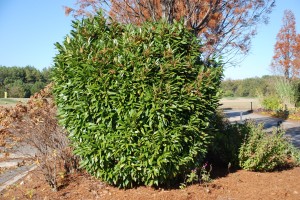Not all cherry laurels (Prunus laurocerasus) are created equal. “Skip” laurel (var. Schipkaensis) and Zabel (var. ‘Zabeliana’) are large size shrubs at 9 to 10 feet in height and 6 to 8 feet in width. Both cultivars are rated the cold hardiest of the tall growing types . ‘Otto Luyken’ is the hardiness small leaf form at 4 to 5 feet in height and 6 to 8 feet in width (USDA hardiness zone 6).
Disease and pest maladies abound, primarily when they’re planted in a poor landscape environment and the site problems are allowed to mount up before proper action is taken. Good soil drainage is a must for cherry laurels. Many varieties become riddled with scale insects, stem cankers, and bacterial shothole disease. Extreme summer drought brings on canker and shot hole diseases. Shoddy irrigation practices often worsen the problems.
Diseased black cherry trees (P. serotina), growing wild in fence rows, contribute to the spread of fungal shot hole on cherry laurel cultivars. Defoliation may not always occur even though spotting is visible.
Pruning off diseased branches and spraying pesticide help to reduce or eliminate disease infections. Banner MAXX® or Captan® fungicides at spring bud break protect healthy foliage from fungal shot hole.
Bacterial shot hole is also common in skip and Otto Luyken cherry laurels. Avoid using any one pesticide more than twice in a year to reduce the risk of building resistance.


 Posted in
Posted in 
